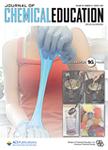版权所有:内蒙古大学图书馆 技术提供:维普资讯• 智图
内蒙古自治区呼和浩特市赛罕区大学西街235号 邮编: 010021

作者机构:Vrije Univ Amsterdam Amsterdam Inst Mol Med & Syst Med Chem Sect Amsterdam Netherlands Vrije Univ Amsterdam Dept Res & Theory Educ Amsterdam Netherlands
出 版 物:《JOURNAL OF CHEMICAL EDUCATION》 (化学教育杂志)
年 卷 期:2014年第91卷第11期
页 面:1830-1837页
核心收录:
学科分类:0401[教育学-教育学] 07[理学] 0703[理学-化学]
主 题:First-Year Undergraduate/General High School/Introductory Chemistry Second-Year Undergraduate Upper-Division Undergraduate Internet/Web-Based Learning Testing/Assessment Medicinal Chemistry Drugs/Pharmaceuticals Molecular Modeling
摘 要:Interactive teaching with larger groups of students can be a challenge, but the use of mobile electronic devices by students (smartphones, tablets, laptops) can be used to improve classroom interaction. We have examined several types of tasks that can be electronically enacted in classes and practical courses using these devices: multiple choice (MC) questions;open-ended questions;and 3D visualization of (bio)molecules and complexes. We have introduced these tasks dynamically in several educational contexts in our teaching programs. Specifically, attention is paid to applying devices in introductory quizzes at the start of a course, throughout lectures, and in practical courses. Each application has been found by us to offer significant merits in terms of connecting theory and practice, full formative assessment (including an improvement in interactions of introverted students), monitoring progress, engaging students early on in research, stimulating 3D molecular feeling, and maintaining student attention. From the student perspective, evaluations revealed overall positive feedback on several key aspects of our approaches. In all, we believe that this mutually beneficial way of teaching can be of broader application, also in nonchemistry-related curricula.